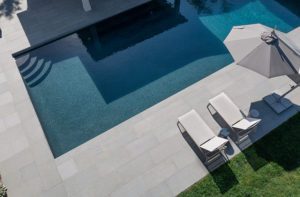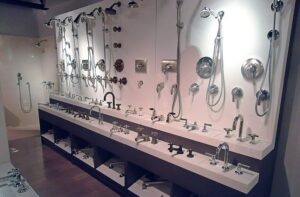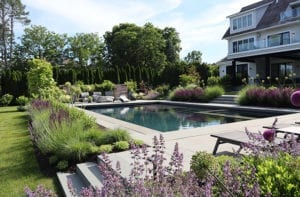Choosing Decorative Lighting Like a Designer
November 1, 2019
Sponsored Content
Text by Kaitlin Madden
Every room needs proper illumination––there’s no arguing that. But choosing decorative lighting based on function alone would be seriously selling it short.
“Decorative lighting is a functional accessory item, but it’s also like the jewelry, the handbag, the shoes of a space,” explains Jennifer Palumbo, a Newton, Mass.-based interior designer. “It’s the element that can drive home a style point of view or take a room from mediocre to special. Designers get really excited about lighting because it’s a category with a lot of artistic freedom.”
So, if you’re currently searching for decorative lighting for your own space, take a cue from an expert and use it as a chance to make your room pop. Here, Palumbo shares a few key ways you can start contemplating decorative lighting ideas like a designer.
Play with Scale
There are certain oft-cited rules that apply to choosing the scale of a light. For instance: a fixture hung above a dining table should be about half the size of the table. While those rules serve as a good guideline, abiding by them too closely could mean missing out on a major design moment.
“There are reasons to overscale a light fixture, for drama purposes or to appropriately fill a large volume space,” she says. “It also makes sense to intentionally underscale a fixture, such as if you’re working in a modern setting or if we want the fixture to be a punctuation mark and not a focal point. This applies to all kinds of lighting: hanging lamps, sconces, and floor and table lamps.”
For example?
In the coastal home above, Palumbo and her team chose a large, sculptural floor lamp to serve as a feature of the room. “The scale is imposing, so it almost functions as an art piece in the vignette. It also helps define this reading nook within a bigger space that also has a TV area and a workspace.”
In a sprawling mountain house, Palumbo scaled-up the overhead fixtures to fill an expansive space and balance an imposing view. “We wanted to make sure we filled the volume of the room so there was some substance, but we went with a transparent fixture because of the view,” she explains.
Underscale or smaller fixtures can be the right choice based on the style of the room, or when done as a reaction to a larger lighting moment. “We often underscale based on the feel of the space, especially when the goal is a room that’s a little more clean and modern,” says Palumbo. “Other times, the fixtures are more of a punctuation. Instead of taking over the elevation like an overscale fixture might, smaller accent lighting adds a punctuation point in a larger context.”
Choose the Right Materials
These days, lighting can be found in a wide range of materials––from metals and twine, to milk glass and mesh … and everything in between. The best way to narrow down the right material for your home is to take a cue from the style of your space. “When you select lighting, it’s important to look at the materials used to craft the fixture and how that fits the setting,” says Palumbo. The ones you choose can either underscore or contrast a design concept.
To play up a nautical feel in a coastal home, for example, Palumbo and her team chose an entryway fixture made of glass bubbles and knotted-rope. The marine vibe sets the tone for the home from the minute you walk through the front door.
In a beach house with a more rustic scheme, Palumbo opted for a fixture made with driftwood, “which help sells the aesthetic of the home,” she says.
Finally, in a bright and modern kitchen, Palumbo chose glass fixtures to add dimension to the space while maintaining the clean design. “The intention of the light was to introduce a new material, the transparent glass, but do it in such a way that it fits the light-and-bright aesthetic of the house,” Palumbo explains.
Consider Composition
Composition, or the way lighting works with the other elements in a room, is often what elevates a designer’s work beyond what a DIY-er might arrange.
To ensure the right composition, Palumbo first considers the impact her choice of the statement fixture has on the rest of the lighting plan for the room.
“I usually start with a primary decorative fixture––or the one we want you to see when you walk into a space. Then, we’ll either support it with recessed lighting to get the right amount of light, or we’ll use secondary and tertiary lighting like sconces and table lamps placed at a different level than the hanging fixture is,” Palumbo says.
But the lighting should also complement the other stylistic elements of the room, like architecture, furniture style, and layout.
In a dining room with a table that serves as a strong central axis, Palumbo chose a pair of single hanging pendants to help balance the space and reinforce its symmetry. On the flip side, a buttoned-up room with traditional bones called for a dimensional cluster fixture to break up the clean lines. “It adds variability and loosens up the room,” the designer explains.
In the context of a room as a whole, the right lighting can even help balance imperfections. In a modern kitchen she and her team designed recently, the ceiling beams were not perfectly aligned with the island. The solution? An asymmetrical lighting arrangement, which made the space feel more artful and took the focus off of the beams.
Overall, says Palumbo, it’s important to consider the way decorative lighting plays into the style of the room––and the earlier you start thinking about it, the better. “We think about lighting out of the gate,” she says. “What do we want the big bang to be, and how can everything else support it?”
Jennifer Palumbo, Newton, Mass., 617-332-1009, jenniferpalumbo.com
Share
![NEH-Logo_Black[1] NEH-Logo_Black[1]](https://www.nehomemag.com/wp-content/uploads/2022/08/NEH-Logo_Black1-300x162.jpg)



















You must be logged in to post a comment.